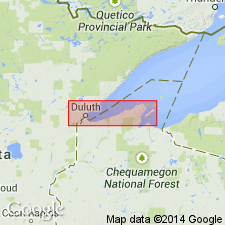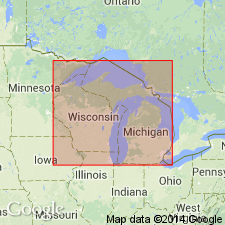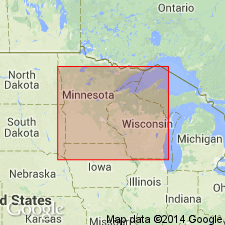
- Usage in publication:
-
- Chequamegon sandstone
- Modifications:
-
- Named
- Dominant lithology:
-
- Sandstone
- AAPG geologic province:
-
- Wisconsin arch
Summary:
Named as top formation in Bayfield group (new). Named for exposures at Chequamegon Bay, Bayfield and Douglas Cos., northwestern WI (Upper Peninsula). Consists of red and white sandstones, predominantly composed of quartz grains, with thin, lenticular beds of red sandy shale. Thickness is 1,000 ft. Overlies Devils Island sandstone (new) of Bayfield group. Age is Precambrian (upper Keweenawan).
Source: GNU records (USGS DDS-6; Reston GNULEX).

- Usage in publication:
-
- Chequamegon Formation
- Modifications:
-
- Age modified
- Revised
- AAPG geologic province:
-
- Wisconsin arch
Summary:
Is part of Bayfield Group which is in turn assigned to Keweenawan Supergroup. Age is Middle Proterozoic, but data from Ostrom and Slaughter (1967) indicates a possible Cambrian age.
Source: GNU records (USGS DDS-6; Reston GNULEX).

- Usage in publication:
-
- Chequamegon Sandstone*
- Modifications:
-
- Overview
- AAPG geologic province:
-
- Lake Superior region
Summary:
Is youngest formation in Bayfield Group in northwest WI in Lake Superior region. Considered youngest Proterozoic sedimentary rocks in Lake Superior region. Is of fluvial and lacustrine origin and is compositionally distinct from underlying Oronto Group. Correlation charts. Normal magnetic polarity. Is considered Middle Proterozoic on basis of relative stratigraphic position, however, has been assigned a Late Proterozoic (King, 1976) or Cambrian (Ostrum, 1967) age.
Source: GNU records (USGS DDS-6; Denver GNULEX).
For more information, please contact Nancy Stamm, Geologic Names Committee Secretary.
Asterisk (*) indicates published by U.S. Geological Survey authors.
"No current usage" (†) implies that a name has been abandoned or has fallen into disuse. Former usage and, if known, replacement name given in parentheses ( ).
Slash (/) indicates name conflicts with nomenclatural guidelines (CSN, 1933; ACSN, 1961, 1970; NACSN, 1983, 2005, 2021). May be explained within brackets ([ ]).

